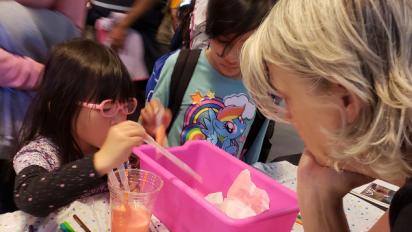Many people in the United States don’t have access to effective community science education. While NCSE’s DIYSci groups are working hard to provide science activities in regions where few informal science education opportunities exist, geography is only one of many barriers to effectively reaching a broader public. These barriers make it more difficult to reach people who have doubts and misconceptions about evolution and climate change.
Story and Fun at the Forefront

Narratives can be universally engaging.
So NCSE’s DIYSci groups are working to serve these underserved communities. In particular, we’re striving to reach a 12-and-older audience that has aged out of traditional outreach. While many community science programs exist for adult learners, they often take the form of science cafés or lectures that presuppose an affinity for science. Community members who have negative memories of high school science class are unlikely to attend these events, let alone pay the typical $15 to $30 price tag.
To draw in folks who may be science-averse, we’ve created free, immersive games, aided by technology like mobile apps, to provide an adult learning experience that puts story and fun at the forefront while still ensuring a rich and engaging science learning experience. To do this effectively, we’ve based the game design on six key principles.
Emphasize story first (then the science)
When adults consider engaging with traditional informal science education activities, they often choose to participate based on whether they think the activity is “for” them—that is, for someone older than a high school kid—and whether they think they can be successful. But narratives can be universally engaging. So our activities first focus on story, helping participants find an entry point into an interesting science question through an engaging narrative. The gameplay elements are based on rigorous science, but allow for a furthering of the narrative.
Real-World Example: For our Evolution of Cooperation activity, we take evolutionary game theory, a topic that requires biology, mathematics, and economics, and make it accessible through the story of a band of chimpanzees figuring out how to survive.
Promote horizontal learning
NCSE believes that everyone has the capability to think scientifically about evolution and climate change. We also know that fear of being wrong is a major reason that adults feel discouraged from participating in outreach. Therefore, we want to move away from the traditional framing of outreach interpreter as leader and the participants as learners. Instead, we’re developing a model where the interpreter helps the participants become invested in the narrative, then assumes a helper role, able to provide clues or similar kinds of support if needed.
Real-World Example: In our summer 2019 activity, Geology Park, volunteer leaders take the role of a time travel guide escorting participants back to the end-Permian extinction. Once they’ve established the story and reviewed basic gameplay, interpreters can help participants solve particularly tough challenges, provide additional information about Phanerozoic creatures, or react in character to events that take place in the game. All scientific inference is done by the participants and, while they do receive immediate feedback on their inferences, it is done privately via a mobile app. They can try as often as they like, allaying any fear of getting the wrong answer.
Incorporate gamification strategically
Just because something has been made into a game doesn’t mean that it drives learning. We apply the stringent guideline that the mechanisms of a game must be intricately linked to our learning goals. That means matching games, memory games, or games that use a game element for its own sake don’t make the cut. The mechanisms must resemble the mechanisms that scientists actually use.
Real-World Example: In our flu evolution immersive activity, we create a scenario that requires participants to think like an epidemiologist as they use demographics, imagined patient records, and interviews with nurses, doctors, and ambulance drivers to determine which areas have the greatest potential for a flu outbreak.
Allow for nuances
While outreach aimed at children is often designed to be short and lacking in nuance, the audience of adult learners can appreciate more subtle explorations. This is particularly important when addressing misconceptions about climate change and evolution.
Real-World Example: In our Climate Change Summit activity, we provide summary views and data for each of eight stakeholder positions assessing the best way to deal with current climate change issues such as irrigation and fish ladder needs caused by water shortages. We help participants see that there is no one perfect solution, but rather a series of compromises that are necessary in order to face the coming challenges.
Create multiple means of success
When scientists collaborate, they bring their own individual strengths to the partnership. There is not a single set of personality traits that makes an effective scientist, and we want to capture this in our game design. Furthermore, we recognize that in science there is often not a single goal. With that in mind, we’ve created open-ended games that prioritize discovery over completing particular tasks. This helps us recontextualize science as a field in which anyone who has a curious mind can find success rather than one in which investigators succeed or fail.
Real-world example: In our Digestion game, players take on the identity of the carbohydrates, fats, and proteins of a food of their choice being digested in the stomach. Moving between different organs requires gaining an understanding of how digestion works, but there is no one set goal. Rather, participants receive rewards for the places they’ve managed to find via their exploration of the space.
Drive further engagement
Even the most effective informal science education activity is limited by being a single interaction. While NCSE adheres to this model because of our mandate to reach across multiple underserved communities, we also build games that encourage participants to take the next step at home.
Real-world example: All our games include a take-home version of the immersive experience, available via a website or app. This version not only summarizes the activity but also allows for further action and engagement.
Guided by these principles, NCSE has created five immersive games that debuted in the summer and fall of 2019. If you live near one of our current outreach partners, you’ll be able to participate in our summer 2019 game, Geology Park. If you don’t, email me about starting your own outreach affiliate!
This version might differ slightly from the print publication.



